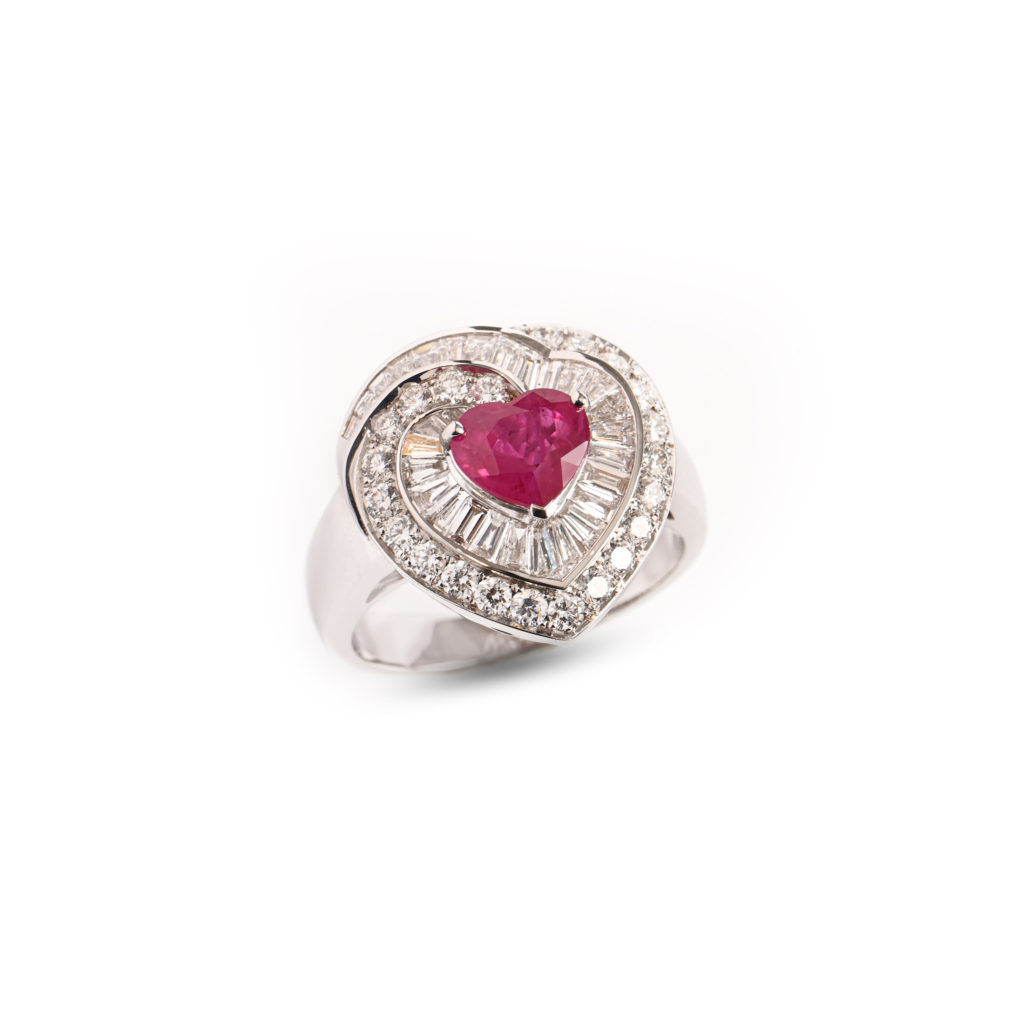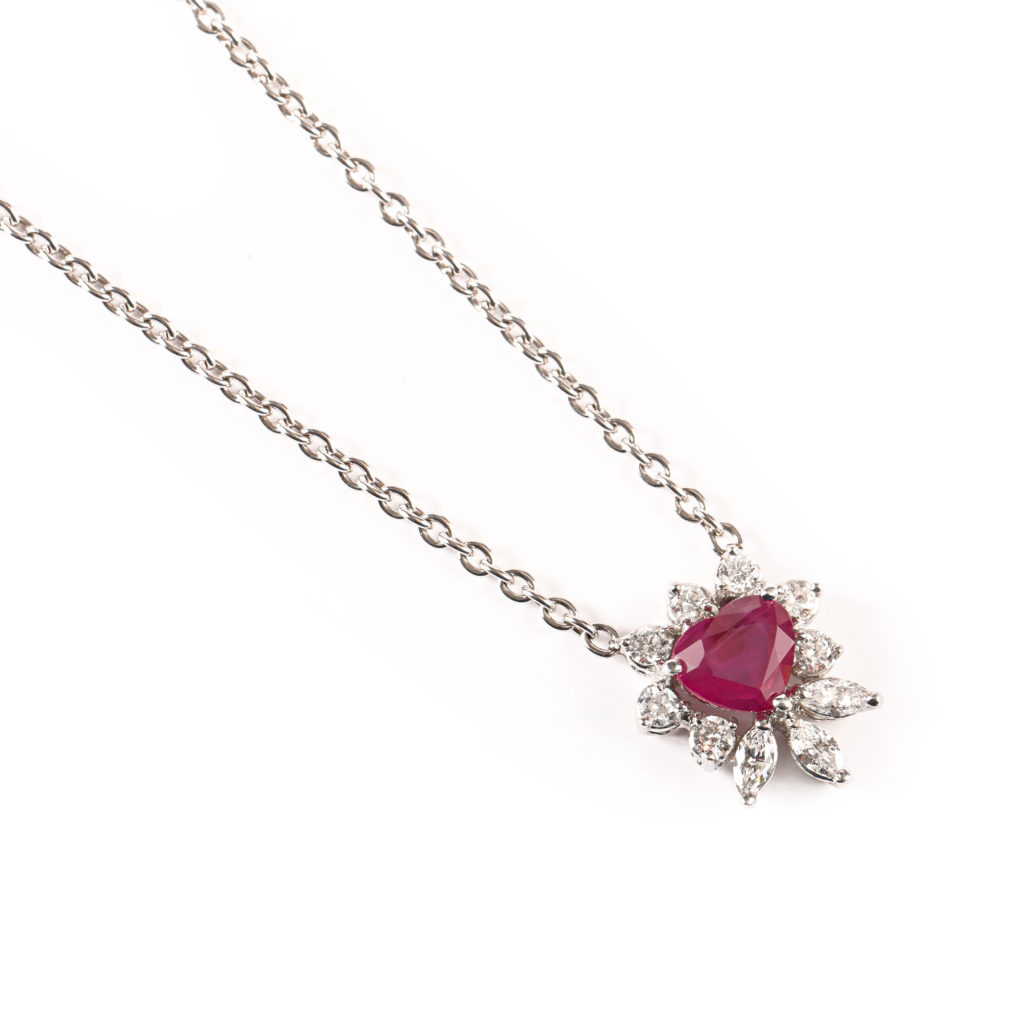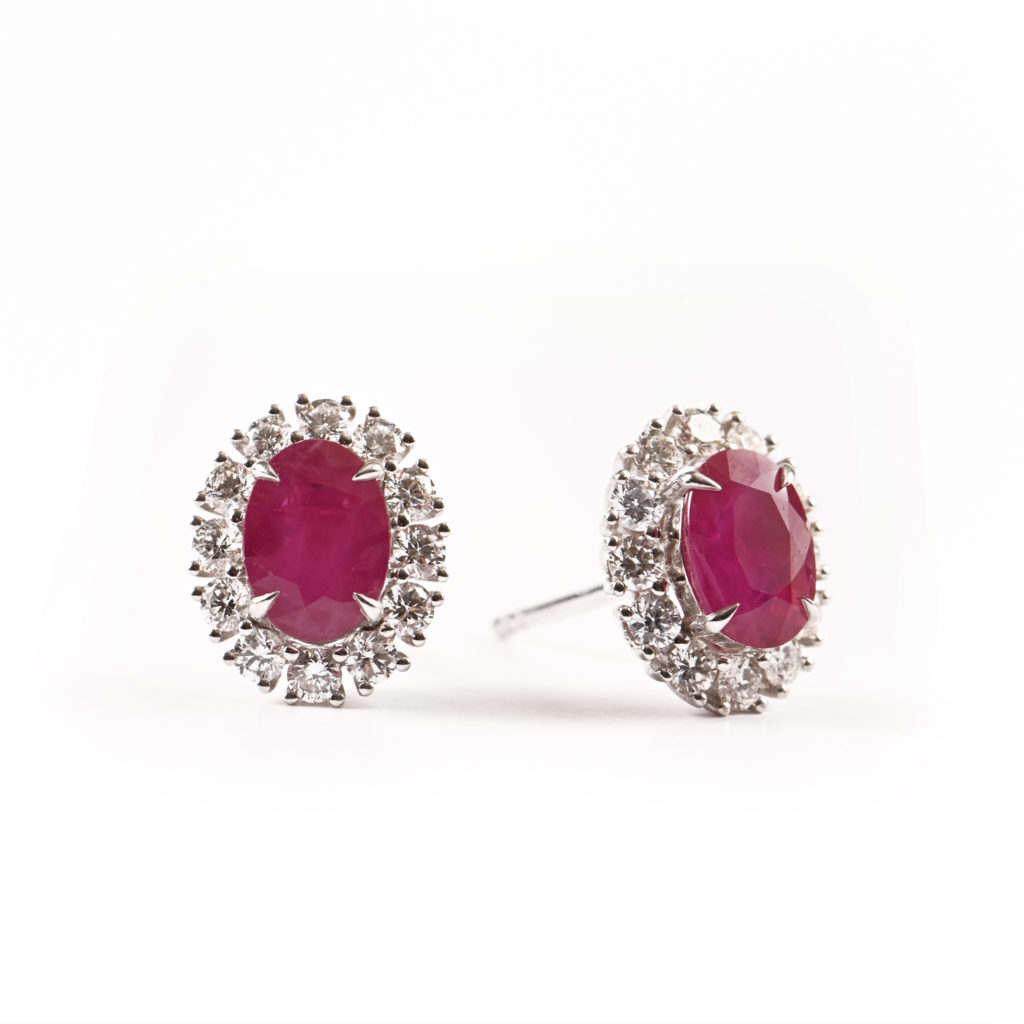It’s very probable that humans discovered rubies about 3000 bc. The famous Mogok mining area of Burma (now the Union of Myanmar) has been so heavily mined for so many thousands of years that evidence is rare. Yet the caves were once so rich that it’s unlikely that the early cavedwelling, tool-wielding humans who lived there weren’t aware of the dazzling red corundum crystals around them. There are documented references to ruby from far back in history, however. The Old Testament describes the “ruby” in a high priest’s breastplate. Ancient Sanskrit texts honor ruby with the word “ratnaraj,” meaning “king of precious stones.
To be considered ruby, corundum must have a red color that falls within a certain range.
Some gems come in ruby-like colors, and they’re often given names that link them to ruby. These include “rubellite” for red tourmaline, “rubolite” for red opal, “rubicelle” for red spinel, and “rubace” for red-stained quartz.
Ruby’s coveted red ranges from medium to dark orangy red to purplish red. Red must be the dominant color for corundum to be considered ruby. If the stone is reddish orange, it’s considered an orange sapphire. If it’s reddish purple, it’s a purple sapphire
People once believed rubies could ensure a peaceful life. Wearing ruby, they thought, could bring health, wealth, wisdom, and love. People believed that if you wore a ruby in a ring on the left hand or in a brooch on the left side, it would give you a magical ability to live in peace among your enemies.
Ruby Sources
The name Burma is practically synonymous with fine-quality ruby. Political changes led to the renaming of the country as Myanmar, but many people in the gem trade still refer to Burma when they talk about the source of the world’s most prized rubies. The first Burmese mines were located in Mogok, and production fluctuated through much of the post-World War II era. The discovery of a rich deposit in Mong Hsu helped the country get back to the forefront of ruby producers.
Other locations have also emerged as important ruby sources. One of those is the African nation of Mozambique. Ruby production began there in early 2006, and the area has since become the world’s most important ruby source. Sri Lanka is also a significant producer, yielding steady supplies to the ruby market. The quality of rubies from Thailand, Cambodia, and Vietnam sometimes rivals Myanmar’s output. Afghanistan, Kenya, Madagascar, Malawi, Tajikistan, and Tanzania are a few of the world’s other ruby sources.
Mozambique has become the world’s most important ruby source
Most natural rubies are heat-treated to improve their color
Ruby Value Factors
Color is the most significant factor affecting a ruby’s value. Ruby hues range from orangy red to purplish red. The finest ruby has a pure, vibrant red to slightly purplish red hue and the highest-quality rubies have vivid saturation. Orangy or more purplish rubies are less valuable. Most people prefer medium to medium-dark tones as long as the stone isn’t so dark that it has a negative effect on brilliance. At the other extreme, if the stone is too light, it’s considered pink sapphire, even if the color is vivid. As you’ve read, dealers and retailers often debate the borderline between ruby and pink sapphire. Historically, the word ruby referred to shades of red, which technically included pink. But the names ruby and pink sapphire reflect a wide difference in value. That’s why, given a choice, a seller would prefer to be able to call a corundum gem ruby rather than pink sapphire
It’s very probable that humans discovered rubies about 3000 bc. The famous Mogok mining area of Burma (now the Union of Myanmar) has been so heavily mined for so many thousands of years that evidence is rare. Yet the caves were once so rich that it’s unlikely that the early cavedwelling, tool-wielding humans who lived there weren’t aware of the dazzling red corundum crystals around them. There are documented references to ruby from far back in history, however. The Old Testament describes the “ruby” in a high priest’s breastplate. Ancient Sanskrit texts honor ruby with the word “ratnaraj,” meaning “king of precious stones.
To be considered ruby, corundum must have a red color that falls within a certain range.
Some gems come in ruby-like colors, and they’re often given names that link them to ruby. These include “rubellite” for red tourmaline, “rubolite” for red opal, “rubicelle” for red spinel, and “rubace” for red-stained quartz.
Ruby’s coveted red ranges from medium to dark orangy red to purplish red. Red must be the dominant color for corundum to be considered ruby. If the stone is reddish orange, it’s considered an orange sapphire. If it’s reddish purple, it’s a purple sapphire
People once believed rubies could ensure a peaceful life. Wearing ruby, they thought, could bring health, wealth, wisdom, and love. People believed that if you wore a ruby in a ring on the left hand or in a brooch on the left side, it would give you a magical ability to live in peace among your enemies.
Ruby Sources
The name Burma is practically synonymous with fine-quality ruby. Political changes led to the renaming of the country as Myanmar, but many people in the gem trade still refer to Burma when they talk about the source of the world’s most prized rubies. The first Burmese mines were located in Mogok, and production fluctuated through much of the post-World War II era. The discovery of a rich deposit in Mong Hsu helped the country get back to the forefront of ruby producers.
Other locations have also emerged as important ruby sources. One of those is the African nation of Mozambique. Ruby production began there in early 2006, and the area has since become the world’s most important ruby source. Sri Lanka is also a significant producer, yielding steady supplies to the ruby market. The quality of rubies from Thailand, Cambodia, and Vietnam sometimes rivals Myanmar’s output. Afghanistan, Kenya, Madagascar, Malawi, Tajikistan, and Tanzania are a few of the world’s other ruby sources.
Mozambique has become the world’s most important ruby source
Most natural rubies are heat-treated to improve their color
Ruby Value Factors
Color is the most significant factor affecting a ruby’s value. Ruby hues range from orangy red to purplish red. The finest ruby has a pure, vibrant red to slightly purplish red hue and the highest-quality rubies have vivid saturation. Orangy or more purplish rubies are less valuable. Most people prefer medium to medium-dark tones as long as the stone isn’t so dark that it has a negative effect on brilliance. At the other extreme, if the stone is too light, it’s considered pink sapphire, even if the color is vivid. As you’ve read, dealers and retailers often debate the borderline between ruby and pink sapphire. Historically, the word ruby referred to shades of red, which technically included pink. But the names ruby and pink sapphire reflect a wide difference in value. That’s why, given a choice, a seller would prefer to be able to call a corundum gem ruby rather than pink sapphire
It’s very probable that humans discovered rubies about 3000 bc. The famous Mogok mining area of Burma (now the Union of Myanmar) has been so heavily mined for so many thousands of years that evidence is rare. Yet the caves were once so rich that it’s unlikely that the early cavedwelling, tool-wielding humans who lived there weren’t aware of the dazzling red corundum crystals around them. There are documented references to ruby from far back in history, however. The Old Testament describes the “ruby” in a high priest’s breastplate. Ancient Sanskrit texts honor ruby with the word “ratnaraj,” meaning “king of precious stones.
To be considered ruby, corundum must have a red color that falls within a certain range.
Some gems come in ruby-like colors, and they’re often given names that link them to ruby. These include “rubellite” for red tourmaline, “rubolite” for red opal, “rubicelle” for red spinel, and “rubace” for red-stained quartz.
Ruby’s coveted red ranges from medium to dark orangy red to purplish red. Red must be the dominant color for corundum to be considered ruby. If the stone is reddish orange, it’s considered an orange sapphire. If it’s reddish purple, it’s a purple sapphire
People once believed rubies could ensure a peaceful life. Wearing ruby, they thought, could bring health, wealth, wisdom, and love. People believed that if you wore a ruby in a ring on the left hand or in a brooch on the left side, it would give you a magical ability to live in peace among your enemies.
Ruby Sources
The name Burma is practically synonymous with fine-quality ruby. Political changes led to the renaming of the country as Myanmar, but many people in the gem trade still refer to Burma when they talk about the source of the world’s most prized rubies. The first Burmese mines were located in Mogok, and production fluctuated through much of the post-World War II era. The discovery of a rich deposit in Mong Hsu helped the country get back to the forefront of ruby producers.
Other locations have also emerged as important ruby sources. One of those is the African nation of Mozambique. Ruby production began there in early 2006, and the area has since become the world’s most important ruby source. Sri Lanka is also a significant producer, yielding steady supplies to the ruby market. The quality of rubies from Thailand, Cambodia, and Vietnam sometimes rivals Myanmar’s output. Afghanistan, Kenya, Madagascar, Malawi, Tajikistan, and Tanzania are a few of the world’s other ruby sources.
Mozambique has become the world’s most important ruby source
Most natural rubies are heat-treated to improve their color
Ruby Value Factors
Color is the most significant factor affecting a ruby’s value. Ruby hues range from orangy red to purplish red. The finest ruby has a pure, vibrant red to slightly purplish red hue and the highest-quality rubies have vivid saturation. Orangy or more purplish rubies are less valuable. Most people prefer medium to medium-dark tones as long as the stone isn’t so dark that it has a negative effect on brilliance. At the other extreme, if the stone is too light, it’s considered pink sapphire, even if the color is vivid. As you’ve read, dealers and retailers often debate the borderline between ruby and pink sapphire. Historically, the word ruby referred to shades of red, which technically included pink. But the names ruby and pink sapphire reflect a wide difference in value. That’s why, given a choice, a seller would prefer to be able to call a corundum gem ruby rather than pink sapphire





